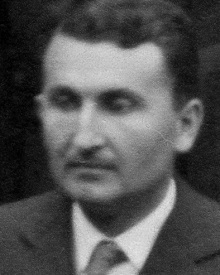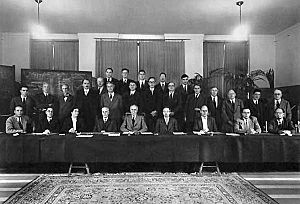Egon Orowan facts for kids
Egon Orowan (born Orován Egon) was a brilliant physicist and metallurgist from Hungary. He was born on August 2, 1902, and passed away on August 3, 1989. Orowan was known as one of "The Martians," a group of talented Hungarian scientists who moved to other countries and made huge discoveries. He became a Fellow of the Royal Society, which is a big honor for scientists in the United Kingdom.
Contents
Life and Discoveries
Egon Orowan was born in Budapest, Hungary. His father was an engineer and factory manager. His mother came from a family that owned land.
Early Studies
In 1920, Egon started studying chemistry and astronomy at the University of Vienna. After some practical training in Hungary, he went to the Technical University of Berlin. There, he first studied mechanical and then electrical engineering.
He soon became very interested in physics. In 1928, he began working with Professor Richard Becker. Orowan earned his doctorate degree in 1932. His research focused on how mica, a type of rock, breaks apart.
Important Work on Materials
In 1933, Adolf Hitler came to power in Germany. Because Orowan had some Jewish heritage, he moved back to Hungary for safety.
In 1934, he wrote a very important paper about "dislocations." These are like tiny flaws or misalignments in the structure of materials. He had done experiments in Berlin that supported this idea. Around the same time, other scientists like Geoffrey Ingram Taylor and Michael Polanyi also came up with similar ideas.
Orowan realized that these dislocations could explain why ductile materials (materials that can bend and stretch without breaking) can be shaped easily. This idea was very important for understanding how materials behave. It helped create the modern science of solid mechanics, which studies how solid objects move and deform.
Work in Hungary and the UK
Finding a job in Hungary was difficult at first. From 1936 to 1939, Orowan worked for a company called Tungsram. They made light bulbs. There, he helped develop a new way to get krypton gas from the air.
In 1937, as war seemed likely, Orowan moved to the University of Birmingham in the United Kingdom. He worked with Rudolf Peierls on understanding "fatigue" in materials. This is when materials weaken and break after being used many times.
In 1939, he moved to the University of Cambridge. There, William Lawrence Bragg inspired him to study materials using x-ray diffraction. This technique uses X-rays to look at the tiny structure of materials.
World War II Contributions
During World War II, Orowan helped with making weapons. He studied how metals flow when they are being shaped, like during "rolling" (making metal sheets).
In 1944, he played a key role in figuring out why many "Liberty ships" were breaking apart during the war. He found that poor quality welds had weak spots, and the extremely cold temperatures of the North Atlantic Ocean made the problem worse.
Later Years in the US
In 1950, Orowan moved to the Massachusetts Institute of Technology (MIT) in the United States. He continued his work on metals. He also became interested in how rocks break in geology and how ice breaks in glaciology.
Throughout his life, Egon Orowan created and patented many new inventions.
Honours and Awards
Egon Orowan received many awards for his important scientific work:
- Fellow of the Royal Society, (1947)
- Member of the American Academy of Arts and Sciences, (1951)
- Member of the National Academy of Sciences, (1969)
- Bingham Medal of the American Society of Rheology, (1959)
- Gauss Medal of the Braunschweiger Wissenschaftliche Gesellschaft, (1968)
- Vincent Bendix Gold Medal of the American Society for Engineering Education, (1971)
- Paul Bergse Medal of the Danish Metallurgical Society, (1973)
- The Acta Metallurgica Gold Medal, (1985)
See also
- The Martians (scientists)



